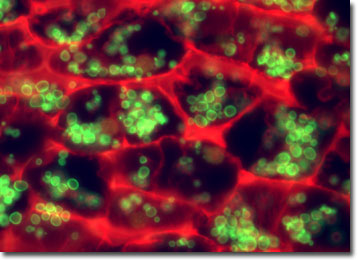Fluorescence Digital Image Gallery
Lily Flower Bud
The lily is an herbaceous flowering plant native to the temperate areas of the northern hemisphere. The name, lily, is most frequently applied to the 80 to 100 species belonging to the genus Lilium of the family Liliaceae.

The lily family comprises more than 250 genera and about 4,000 species of mostly herbaceous flowering plants, many with showy flowers. They are among the oldest cultivated plants, used by the ancient Greeks and Romans for medicinal purposes as well as being prized garden ornamentals. The bulb of the Madonna lily was cultivated by cultures in Asia Minor for use in a ointment as early as the second millennium BC. Other members of the lily family, including garlic, onions, chives, shallots, leeks, and asparagus, are better known for their culinary applications and were used for food by prehistoric humans. The lily flower has held significance for various cultures over thousands of years, usually as a symbol of fertility and rebirth, but also as a symbol of innocence.
The specimen presented here was imaged with a Nikon Eclipse E600 microscope operating with fluorite and/or apochromatic objectives and vertical illuminator equipped with a mercury arc lamp. Specimens were illuminated through Nikon dichromatic filter blocks containing interference filters and a dichroic mirror and imaged with standard epi-fluorescence techniques. Specific filters for the stained lily flower bud thin section were a B-2E/C and a Y-2E/C. Photomicrographs were captured with an Optronics MagnaFire digital camera system coupled to the microscope with a lens-free C-mount adapter.
BACK TO THE FLUORESCENCE DIGITAL IMAGE GALLERY
